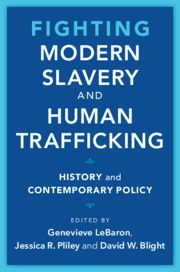28 results
Copyright page
-
- Book:
- Fighting Modern Slavery and Human Trafficking
- Published online:
- 18 June 2021
- Print publication:
- 01 July 2021, pp iv-iv
-
- Chapter
- Export citation
Index
-
- Book:
- Fighting Modern Slavery and Human Trafficking
- Published online:
- 18 June 2021
- Print publication:
- 01 July 2021, pp 251-260
-
- Chapter
- Export citation
1 - Introduction
-
-
- Book:
- Fighting Modern Slavery and Human Trafficking
- Published online:
- 18 June 2021
- Print publication:
- 01 July 2021, pp 1-33
-
- Chapter
- Export citation
Figures
-
- Book:
- Fighting Modern Slavery and Human Trafficking
- Published online:
- 18 June 2021
- Print publication:
- 01 July 2021, pp vii-vii
-
- Chapter
- Export citation
Acknowledgments
-
- Book:
- Fighting Modern Slavery and Human Trafficking
- Published online:
- 18 June 2021
- Print publication:
- 01 July 2021, pp xxi-xxiii
-
- Chapter
- Export citation
Contents
-
- Book:
- Fighting Modern Slavery and Human Trafficking
- Published online:
- 18 June 2021
- Print publication:
- 01 July 2021, pp v-vi
-
- Chapter
- Export citation
Abbreviations
-
- Book:
- Fighting Modern Slavery and Human Trafficking
- Published online:
- 18 June 2021
- Print publication:
- 01 July 2021, pp xxiv-xxiv
-
- Chapter
- Export citation
5 - Ambivalent Abolitionist Legacies
-
-
- Book:
- Fighting Modern Slavery and Human Trafficking
- Published online:
- 18 June 2021
- Print publication:
- 01 July 2021, pp 97-118
-
- Chapter
- Export citation
Tables
-
- Book:
- Fighting Modern Slavery and Human Trafficking
- Published online:
- 18 June 2021
- Print publication:
- 01 July 2021, pp viii-viii
-
- Chapter
- Export citation
Contributors
-
- Book:
- Fighting Modern Slavery and Human Trafficking
- Published online:
- 18 June 2021
- Print publication:
- 01 July 2021, pp ix-xiv
-
- Chapter
- Export citation

Fighting Modern Slavery and Human Trafficking
- History and Contemporary Policy
-
- Published online:
- 18 June 2021
- Print publication:
- 01 July 2021
7 - From White Slavery to Anti-Prostitution, the Long View
- from Part II - Forms of Slavery, Past and Present
-
-
- Book:
- Human Bondage and Abolition
- Published online:
- 10 August 2018
- Print publication:
- 23 August 2018, pp 190-218
-
- Chapter
- Export citation
TROUBLING HABITS, POISONS OF CIVILIZATION, AND STATE GROWTH - Lisa McGirr. The War on Alcohol: Prohibition and the Rise of the American State. New York: W. W. Norton & Co., 2016. 352 pp. $27.95 (cloth), ISBN 978-0-393-06695-1.
-
- Journal:
- The Journal of the Gilded Age and Progressive Era / Volume 17 / Issue 2 / April 2018
- Published online by Cambridge University Press:
- 27 April 2018, pp. 412-415
- Print publication:
- April 2018
-
- Article
- Export citation
6 - Protecting the Young and the Innocent: Age and Consent in the Enforcement of the White Slave Traffic Act
- from Section III - The Child as a Pivot Point between Consent and Complicity
-
-
- Book:
- Child Slavery before and after Emancipation
- Published online:
- 02 March 2017
- Print publication:
- 17 February 2017, pp 156-176
-
- Chapter
- Export citation
Notes on contributors
-
- Book:
- Global Anti-Vice Activism, 1890–1950
- Published online:
- 05 July 2016
- Print publication:
- 04 July 2016, pp ix-xiv
-
- Chapter
- Export citation
List of tables
-
- Book:
- Global Anti-Vice Activism, 1890–1950
- Published online:
- 05 July 2016
- Print publication:
- 04 July 2016, pp viii-viii
-
- Chapter
- Export citation
Index
-
- Book:
- Global Anti-Vice Activism, 1890–1950
- Published online:
- 05 July 2016
- Print publication:
- 04 July 2016, pp 325-333
-
- Chapter
- Export citation
PART I - HEALTH AND THE BODY
-
- Book:
- Global Anti-Vice Activism, 1890–1950
- Published online:
- 05 July 2016
- Print publication:
- 04 July 2016, pp 31-32
-
- Chapter
- Export citation
PART III - PROSTITUTION AND SEX TRAFFICKING
-
- Book:
- Global Anti-Vice Activism, 1890–1950
- Published online:
- 05 July 2016
- Print publication:
- 04 July 2016, pp 219-220
-
- Chapter
- Export citation
PART II - DRINKS AND DRUGS
-
- Book:
- Global Anti-Vice Activism, 1890–1950
- Published online:
- 05 July 2016
- Print publication:
- 04 July 2016, pp 101-102
-
- Chapter
- Export citation



